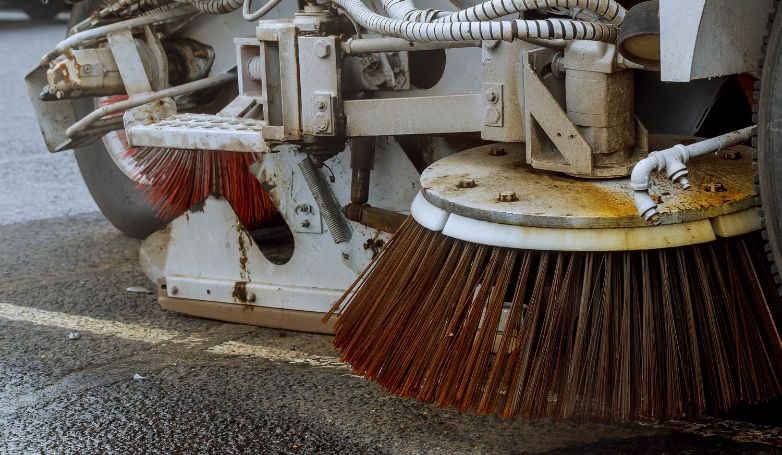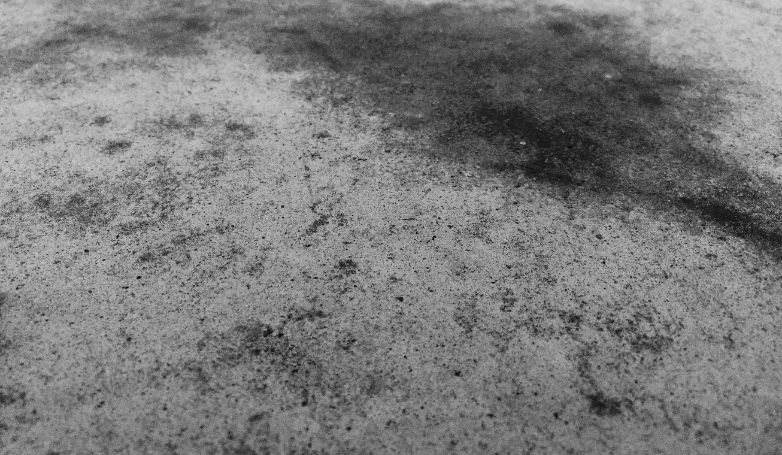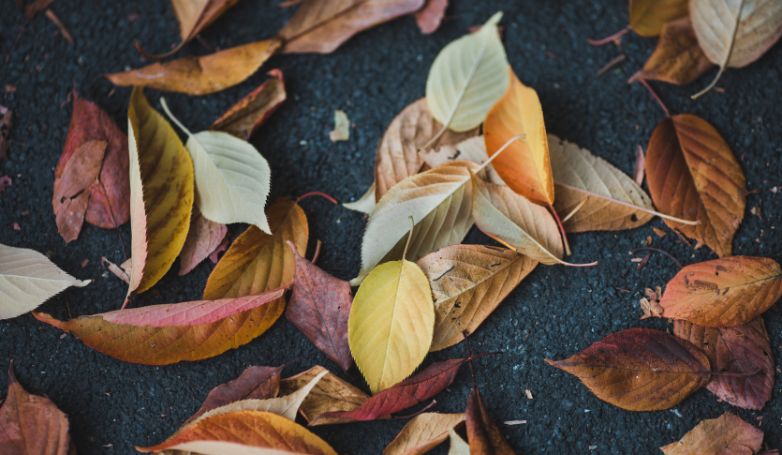How to Remove Oil Stains from an Asphalt Driveway in 5 Steps
Ever struggled with those annoying oil stains on your asphalt driveway? Worry not! Let’s walk through a hassle-free, five-step solution to get rid of those stains and keep your driveway looking sharp.
Got a fresh oil stain? Start by blotting it up with a cloth or mop. Next, sprinkle some cat litter, baking soda, or sawdust over it to absorb the remaining oil. If you’re tackling an older, more stubborn stain, grab some dishwashing liquid or diluted vinegar and a wire brush to scrub it out. Once you’ve given it a good scrub, rinse off all that soapy business. The final touch? Slap on a seal coat to fend off any future stains. This straightforward approach keeps your driveway looking neat without the need for a complete overhaul.
Stick around as we dive into the nitty-gritty of each of these five steps. Plus, we’ll shed light on what typically causes those pesky asphalt stains and share some pro tips on how to tackle other common driveway stains.
Remove Oil Stains from Your Asphalt Driveway in 5 Steps
If you’re tired of asking how to remove oil stains from asphalt driveway, it’s time to get proactive. Here are the 5 steps from the intro in more detail.
Step #1: Sop up Fresh Oil Stains

It’s always best if you can clean an oil stain as soon as it happens. This prevents the oil from settling in, which requires more elbow grease to remove.
If the oil is still fresh, then use an absorbent cloth, a towel, a rag, or a mop to sop up as much oil as you can. You should only do this once, as you won’t be able to get all the oil right now, and that’s okay. Just do what you can at this stage.
Step #2: Draw Out the Remaining Oil
Next, switch to a product that’s known for its absorbency. You have many options, including commercial oil absorbers, coconut husks, gravel, non-clumping clay cat litter, baking soda, or sawdust. Sprinkle the absorber evenly across the entire stain, being very generous as you do, and let the product sit for a while.
The longer the better here, even overnight if you have the time. To prevent wild animals or your own pets from sniffing out the cat litter, sawdust, or coconut husks, take a clean towel and cover the pile. This will not interrupt any oil absorption.
In the morning, when you come back outside, use a broom and a dustpan to clean up the absorber you used. If your stain is especially bad, you might need to repeat this step for another day.
If you’re still asking how to remove oil stains from asphalt driveway, understand that the stain shouldn’t be gone at this point. You’re just absorbing the oil. For older stains especially, using an absorber on the stain will only do so much good.
Step #3: Use Dishwashing Liquid or Diluted Vinegar with a Wire Brush on Older Stains

For older stains or newer, stubborn ones, you’ll have to manually tackle the mess. You can try dishwashing detergent aka dish soap, especially one with degreasing properties. Diluted vinegar should also work. To properly dilute vinegar, you want one cup of water to one cup of vinegar.
A wire brush with stiff bristles is also recommended. Dip your brush into the cleaning mixture and begin scrubbing. Be vigorous with your scrubbing, but not to the point where you risk scratching up the asphalt. Once you’re done scrubbing, you might want to repeat this step a second or even a third time.
Do yourself a favor and skip the heartier cleaners like those with solvents or citrus, as these products may be corrosive. Sure, they will remove the stain, but also part of your asphalt driveway too.
Step #4: Clear Away Residue
Alright, you’ve done the hard part. Now, grab your garden hose and give the driveway a good rinse. Make sure you wash away every bit of soap or vinegar. This isn’t just about cleaning; it’s about preventing any leftover residue from attracting more dirt. After rinsing, let the sun do its job and dry your driveway naturally. If you see any bits and pieces left behind, give it another sweep. You want your driveway looking not just clean, but spotless.
Step #5: Seal Your Asphalt Driveway
Take a step back and admire your work – your driveway’s looking fantastic! But hold on, there’s one last step. Sealing the asphalt is like putting a cherry on top. All that scrubbing might have worn away some of the protective top layer of your driveway.
Sealing it helps bring that layer back and keeps future oil spills from sinking in. Think of it as your driveway’s shield against spills and stains. Follow the sealant instructions carefully – whether you’re rolling it on or spraying it – and make sure you cover the whole driveway evenly. Let it dry properly; patience is key here. This final touch not only makes your driveway look great but also extends its life.
What Causes Stains on Asphalt?
Now that you know how to remove oil stains from an asphalt driveway, it’s time to address another important question. How do the stains get there in the first place? Here are some common sources of unappealing driveway stains.
Spilled Oil

Let’s start with the obvious one: oil stains on your asphalt are caused by spilled oil. Perhaps you decided to save a trip to your dealership this year so you took care of the oil change yourself. Only this was your first time doing it, so it got a bit messy.
Outside of that, a leaky car can also stain your driveway. Your vehicle shouldn’t leave puddles of fluid everywhere you park. Schedule an appointment with your mechanic soon and get the issue fixed. If you don’t, you’ll only leak more oil, leading to you having to do everything above all over again!
Uncleaned Mulch
You planned on adding some mulch around the trees on your front yard, but the project got derailed. The mulch sat there in your driveway, first for weeks, then for months before you finally cleaned it up. What remains is sort of like a shadow of where the mulch was.
You thought this was just leftover mulch you can sweep up, but no such luck. What you have now is another stain. Darn.
Decayed Leaves

Leaves are so pretty when they begin falling off the trees in the autumn. While many homeowners prioritize raking their lawns, you don’t want the leaves to stay on your driveway either. As you step on them, you accelerate the decay of the leaves. Even if the leaves are untouched, by letting them sit on the asphalt all autumn, the leaves will again decay. As the leaves break down, they stain your driveway.
Grease Spills
Ever noticed those dark, slick spots on your driveway? That’s usually from grease spills. They’re a common headache, especially if you’re into car repairs or outdoor grilling. Grease has a way of sneaking into asphalt’s pores, leaving stains that don’t go away with just a hose-down. The key here? Tackle these spills quickly to stop them from setting in and causing a bigger mess.
Leaking Automotive Fluids
Cars can be messy, leaking fluids like oil and coolant that love to stain driveways. These aren’t just ugly; they can actually eat away at your asphalt over time. It’s like a double whammy – they look bad and can cause damage. So, keeping an eye on any drips and dealing with them pronto can save your driveway from serious trouble.
Rust from Metal Objects
Rust stains come from metal things left lying around, like tools or old bike parts. They leave these orange-brown marks that stick out like a sore thumb. Rust is a tough customer, and you’ll need something stronger than soap and water to get rid of it.
Chemical Spills
Spilling chemicals on your driveway is bad news. We’re talking cleaning products, pesticides, all that stuff. They can do a number on your asphalt, leading to stains and even damage. If you spill something, clean it up quick to keep your driveway in top shape.
3 Steps for Removing Other Stains on Asphalt

Your question now isn’t how to remove oil stains from an asphalt driveway, but leaf and mulch stains. Oh, and you’re curious about how to get rid of paint and chalk stains too. Fortunately, the methods you follow aren’t all that different from what we discussed earlier. Here’s what to do.
Step 1: Clean up Your Driveway
Before you dive into stain removal, let’s get your driveway ready. Think of it like prepping a canvas before painting. Give it a good sweep to clear off leaves, dirt, and other bits and pieces. This isn’t just about making it look neat – you’re stopping that stuff from getting ground in and making the stain worse. Avoid the temptation to blast it with a pressure washer though, as that might push the debris and the stain deeper into your asphalt.
Step 2: Clean with Dishwashing Detergent or Diluted Vinegar + Bristle Brush
Now, onto the main event. Grab your diluted vinegar or dishwashing soap – your secret weapons. Splash some on the stain and let it get to work. Don’t be shy with the scrubbing, either. That stiff-bristled brush isn’t just for show – it’s your trusty sidekick in this battle against stubborn stains like mulch marks or chalk leftovers. Pro tip: if you’ve got time, let the vinegar or soap sit for a few hours, or even overnight. It’s like marinating a steak – the longer it sits, the better the results. This might just save you from round two of scrubbing.
Step 3: Rinse the Residue
Alright, final stretch! Hose down your driveway to wash away all the vinegar or soap residue. And just like that, you’re done! Stand back and admire your handiwork. Your driveway is not only stain-free but also has probably never looked better.
FAQs about How to Remove Oil Stains from an Asphalt Driveway

Here are some frequently asked questions that can help guide you through the process effectively.
What is the best oil stain remover for asphalt?
When it comes to getting rid of oil stains on asphalt, there’s no one-size-fits-all answer. It often depends on how stubborn the stain is. For fresh spills, something as simple as dish soap can work wonders. For tougher, set-in stains, commercial degreasers or a concoction of baking soda and vinegar can do the trick. Just remember, the sooner you tackle the stain, the better your chances of getting rid of it.
Can old oil stains be removed from driveway?
Yes, old oil stains can be removed, but it’s a bit more challenging than dealing with fresh spills. You’ll need to put in some elbow grease. A mixture of laundry detergent and warm water, left to sit on the stain for a while before scrubbing, can help lift those stubborn spots. For really tough stains, a commercial asphalt cleaner or a poultice made from sawdust and paint thinner might be necessary.
Can you pressure wash oil stains off asphalt?
Pressure washing can be effective, but it’s not always the first solution you should jump to. For light stains, pressure washing with just water might work. But for more stubborn stains, you’ll want to apply a degreaser or cleaning solution first, let it sit, and then go in with the pressure washer. Be careful, though – too much pressure can damage the asphalt.
Conclusion
You’ve got the know-how on how to remove oil stains from an asphalt driveway, and it’s simpler than you might have guessed, achievable in just 5 steps. Now, if your asphalt driveway gets hit with other nuisances like leaf, paint, mulch, or chalk stains, you’re well-equipped to tackle those too.
Remember, the key to a pristine driveway isn’t just in the cleaning; it’s in the upkeep. Regularly resealing and cleaning your driveway goes a long way in warding off future stains. Here’s to keeping your asphalt driveway looking its best – good luck!


